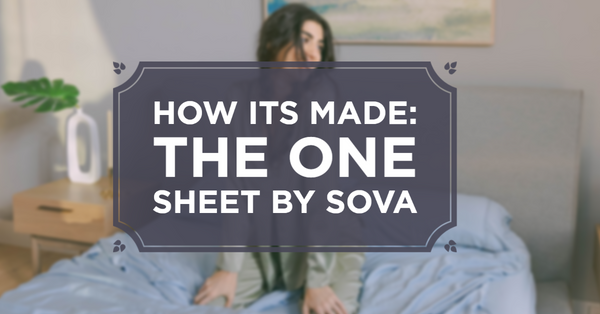
How It's Made: The One Sheet by Sova (The World's First All In One Bedding)
Bamboo viscose bed sheets have gained popularity due to their exceptional comfort, sustainability, and hypoallergenic properties. But have you ever wondered how these luxurious bed sheets are made? In this blog post, we will take you on a journey through the manufacturing process of bamboo viscose bed sheets, from the raw bamboo material to the luxurious all in one bedding set that adorns your bed.
1. Sourcing Sustainable Bamboo:
The manufacturing process begins with the careful selection of sustainable bamboo. Bamboo is a fast-growing plant that requires no pesticides or fertilizers and little water for cultivation. Responsible bamboo farms ensure that the bamboo is harvested using sustainable practices while maintaining ecological balance. The harvested bamboo is then transported to a processing facility.
2. Bamboo Fiber Extraction:
At the processing facility, the bamboo undergoes a mechanical or chemical process to extract the fibers. The mechanical method involves crushing the bamboo stalks and using natural enzymes to break down the plant material. This process is environmentally friendly and preserves the natural qualities of bamboo. The chemical method, known as the viscose process, involves treating the bamboo with chemicals to dissolve it into a viscous solution. Both methods result in bamboo cellulose, which is the base material for bamboo viscose.
3. Filtration and Bleaching:
To remove impurities and any remaining plant debris, the bamboo cellulose undergoes a filtration process. Filtration ensures that the fibers are pure and ready for further processing. After filtration, the bamboo cellulose may go through a bleaching process to achieve the desired color or remove any natural pigments that could affect the final appearance of your One Sheet.
4. Spinning and Drying:
Once the bamboo cellulose is purified, it is spun into fibers. This spinning process transforms the bamboo cellulose into fine, continuous threads. The threads are then dried to remove excess moisture and increase their strength. The drying process is done in part by air drying finished by mechanical drying.
5. Viscose Production:
The dried bamboo threads are immersed in a chemical solution to create a viscose solution. This solution is then forced through spinnerets, which are fine nozzles, to create individual bamboo viscose fibers. These fibers are then solidified in a bath containing a solution that forms them into a continuous filament. The resulting filaments are collected and further processed.
6. Weaving:
The bamboo viscose filaments are spun into yarns which are then used for weaving or knitting the bed sheets. Weaving involves interlacing the yarns on a loom to create the fabric producing a fabric that is soft, smooth, anti-microbial, hypoallergenic and temperature regulating.
8. Finishing:
After weaving or knitting, the bamboo viscose fabric undergoes a finishing process. This includes treatments such as mercerization, which improves the fabric's strength and luster dye is used to add color before they are sewn together creating the all in one bed sheets our customers love!
9. Quality Control and Packaging:
Before the bamboo viscose bed sheets are packaged, they go through rigorous quality control measures. This ensures that the sheets meet Sova’s standards in terms of size, color, and overall quality. Once approved, the bed sheets are carefully folded, packaged, and shipped to us!
The journey from raw bamboo material to luxurious bamboo viscose bed sheets involves a series of meticulous steps. From sustainable sourcing to fiber extraction, spinning, weaving or knitting, and finishing, each stage plays a vital role in creating the ultimate sleep experience. All in one bedding or not, bamboo viscose bed sheets are undoubtedly the best bed sheets on the market and you should certainly give them a try!

